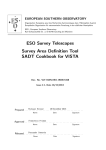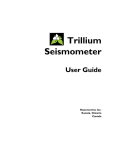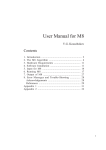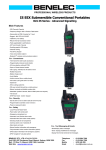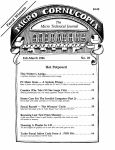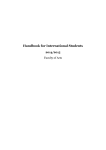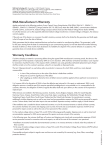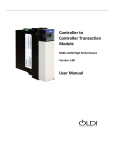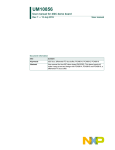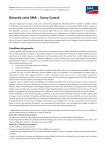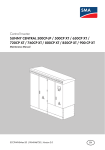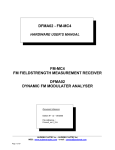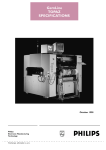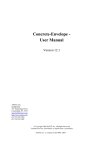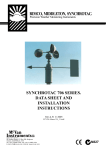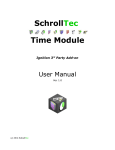Download Package `ssM8` - Homepages Paradise Net Nz
Transcript
Package ‘ssM8’ 24 September 2010 Version 2.1-8 Date 2010-09-24 Title M8 Earthquake Forecasting Algorithm Author David Harte, ported to R and packaged by Ray Brownrigg Maintainer David Harte <[email protected]> Description This package performs the M8 calculations as in Kossobokov (1997). It was originally written for S-PLUS, being part of the Statistical Seismology Library (Harte, 1998), and was translated to R by Ray Brownrigg <[email protected]>. More information about the M8 Algorithm can be found under the topic “changes” along with recent modifications made to the package. Depends ssBase Suggests ssNZ License GPL (>=2) URL http://www.statsresearch.co.nz/software.html R topics documented: Change Log . decluster.M8 . emp.cdf . . . M8 . . . . . . M8.series . . M8.TIP . . . plot.M8 . . . . . . . . . . . . . . . . . . . . . . . . . . . . . . . . . . . . . . . . . . . . . . . . . . . . . . . . . . . . . . . . . . . . . . . . . . . . . . . . . . . . . . . . . . . . . . . . . . . . . . . . . . . . Index . . . . . . . . . . . . . . . . . . . . . . . . . . . . . . . . . . . . . . . . . . . . . . . . . . . . . . . . . . . . . . . . . . . . . . . . . . . . . . . . . . . . . . . . . . . . . . . . . . . . . . . . . . . . . . . . . . . . . . . . . . . . . . . . . . . . . . . . . . . . . . . . . . . . . . . . . . . . . . . . . . . . . . . . . 2 . 4 . 5 . 7 . 8 . 11 . 14 16 1 2 Change Log Change Log Changes Made to the Package Description The M8 algorithm is based on seven different time series (see Keilis-Borok \& Kossobokov, 1990; and Kossobokov, 1997). If the 7th time series and 5 out of the first 6 time series are above certain thresholds, a “Time of Increased Probability” (or TIP) is declared. This means there is an increased probability of an earthquake (of or greater than M0 ) in the next 5 years. Details for the calculation of the seven series can be found in under M8.series, and details for the calling of a TIP can be found under M8.TIP. Li (1997) converted the original M8 FORTRAN code in Kossobokov (1997) into S-PLUS, which was then included into the Statistical Seismology Library (Harte, 1998). Ray Brownrigg subsequently packaged it into R. Analyses using the M8 Algorithm, applied to New Zealand data, have been carried out by Ma \& Vere-Jones (1997), Harte et al. (2003), and Harte et al. (2007). This page contains a listing of recent changes made to functions, and known general problems. Details 1. decluster.M8: The line near the bottom within an else loop: class(minday) <"datetimes" has been commented. (March 2002) 2. plot.M8: Main title now uses default cex.main, vertical lines (type="h") have been removed, horizontal reference line changed to dashed (lty=2), colours removed from plotted symbols, and 8th graph plots only critical series. (January 2003) 3. Occurrences of T and F have been changed to TRUE and FALSE, respectively. (January 2003) 4. M8.TIP: When (training == "moving") the line TIP.type[1:7] <- NA has been changed to TIP.type[1:7] <- "". When (training == "user" || training == "all") the line TIP.type[1] <- NA has been changed to TIP.type[1] <"". The earlier versions caused errors when running R CMD check in R\ version 1.6.2. (February 2003) 5. plot.M8: argument M8 changed to x, and argument . . . added to fix generic/method inconsistencies. (June 2003) 6. print.mainshocks has been renamed to prt.mainshocks to fix generic/method confusion. (June 2003) 7. time.grid has been renamed to timegrid to fix generic/method confusion. (June 2003) 8. M8.TIP: the check to see if the critical series has length less than seven now uses function nrow rather than start and end. (October 2003) 9. decluster.M8: a vector is now returned that identifies the mainshock to which each aftershock belongs. (October 2003) 10. Minor formatting corrections to manual pages. (December 2003) 11. Minor documentation formatting changes, mainly to use \dQuote. (January 2004) 12. in.circle: correct documentation mismatch with code. (7 May 2004) 13. decluster.M8: PACKAGE="ssM8" has been added to the .Fortran("recat", ...) call within the function. (7 May 2004) 14. sum.row renamed to sumrow. (7 May 2004) Change Log 3 15. A statement require(ssNZ) has been added to the examples that use the NZ catalogue. Hence ssNZ is no longer a “package” requirement of ssM8. (25 May 2004) 16. M8.series: statement with incorrect logical syntax corrected: cover.breaks <(time.breaks[1] <= catalogue[, "time"] <= time.breaks[n]) (17 Feb 2005) 17. M8.TIP: make documentation consistent with Harte et al (2003). (17 Feb 2005) 18. M8.TIP: method of calculating the quantiles in variable tops incorrect, redone using the function quantile. Values of g and h included in output list object. Variable initialisation rewritten. Code included to calculate TIP.level when training=="moving", previously not working for this option. (24 Mar 2005) 19. emp.cdf: completely rewritten, see documentation. (11 Apr 2005) 20. Old package “stepfun” not now “required”. Part of base. (19 Apr 2005) 21. decluster.M8: on manual page, units added for space and time windows. (9 Jul 2006) 22. All occurences of subset.rect in the Examples have been changed to subsetrect. See Changes in ssBase. (8 Nov 2007) 23. ssNZ added to Suggests in the DESCRIPTION file. Corresponding changes made to examples on manual pages. (10 Jan 2008) 24. Use of require(ssNZ) in examples made consistent with package ssEDA. (28 Jan 2008) 25. References updated below. (28 Jan 2008) 26. Package vignettes added. (28 Jan 2008) 27. Removal of LaTeX markups from DESCRIPTION file. (31 May 2009) 28. Minor manual page changes to conform to R\ 2.10.0. (13 Nov 2009) 29. M8.TIP: called a function stoptmp, non-existent, changed to stop. (13 Nov 2009) 30. timegrid: internal function, not used, deleted. (17 Nov 2009) 31. Changes: correct hyperlink from package vignettes. (11 Feb 2010) 32. Add CITATION file. (24 Sep 2010) References Harte, D. (1998). Documentation for the Statistical Seismology Library. School of Mathematical and Computing Sciences Research Report No. 98-10 (Updated Edition June 1999), Victoria University of Wellington. (ISSN 1174-4545) Harte, D.; Li, D.-F.; Vreede, M. \& Vere-Jones, D. (2003). Quantifying the M8 prediction algorithm: Reduction to a single critical variable and stability results. NZ Journal of Geology and Geophysics 46(1), 141–152. URL: http://www.rsnz.org/publish/nzjgg/2003/ 010.php Harte, D.; Li, D.-F.; Vere-Jones, D.; Vreede, M. \& Wang, Q. (2007). Quantifying the M8 algorithm: Model, forecast and evaluation. NZ Journal of Geology and Geophysics 50(2), 117–130. URL: http://www.rsnz.org/publish/nzjgg/2007/012.php Keilis-Borok, V.I. and Kossobokov, V.G. (1990). Premonitory activation of earthquake flow: algorithm M8. Physics of the Earth and Planetary Interiors 61, 73–83. URL: http://dx.doi. org/10.1016/0031-9201(90)90096-G Kossobokov, V.G. (1997). User manual for M8. In: Algorithms for Earthquake Statistics and Prediction. International Association of Seismology and Physics of the Earth’s Interior (IASPEI) 4 decluster.M8 Library Volume 6. Pages 167–222. (Edited by J.H. Healy, V.I. Keilis-Borok and W.H.K. Lee). IASPEI, Menlo Park CA. Li, Dongfeng. (1997). M8-Splus Documentation. Internal Report, Institute of Statistics and Operations Research, Victoria University of Wellington. Ma, L. and Vere-Jones, D. (1997). Application of the M8 and Lin-Lin algorithms to New Zealand Earthquake data. NZ Journal of Geology and Geophysics 40, 77–89. URL: http://www.rsnz. org/publish/nzjgg/1997/7.php decluster.M8 Decluster Catalogue Using M8 Method Description The function reads an earthquake catalogue (with class "catalogue"), deletes events with magnitude below a cutoff level and all aftershocks, optionally deletes events with depth too deep or too shallow, and counts the number of aftershocks in the 14 days following each remaining mainshock. The output is also a "catalogue" object containing the mainshock information and an additional variable with the corresponding number of aftershocks. Usage decluster.M8(catalogue, cutoff.mag=4, minday=min(catalogue$time), mindepth= - Inf, maxdepth=Inf, debug=FALSE, decluster.name="", magn.window = c(3, 3.5, 4, 4.5, 5, 5.5, 6, 6.5, 7, 7.5, 8), space.window = c(30, 40, 40, 40, 50, 50, 50, 100, 100, 150, 200), time.window = c(6, 11, 23, 46, 91, 183, 183, 365, 730, 913, 1096)) Arguments catalogue the catalogue. It should be a "catalogue" object. decluster.name character string containing the name of the declustered catalogue. cutoff.mag the magnitude below which the record is cutoff before going through the mainshockaftershock separation. Default 4.0. minday number of days from 1 January 1970 (julian). If specified, then after mainshocks have been separated out, mainshocks before this date are dropped. If not specified, no mainshocks are dropped. mindepth all events with depth less than mindepth are deleted before entering algorithm. Default is -Inf. maxdepth all events with depth greater than or equal to maxdepth are deleted before entering algorithm. Default is Inf. magn.window a vector giving the magnitude window boundaries. The default c(3, 3.5, 4.0, 4.5, 5.0, 5.5, 6.0, 6.5, 7.0, 7.5, 8.0). time.window a vector giving the time window boundaries (days). The default is c(6, 11, 23, 46, 91, 183, 183, 365, 730, 913, 1096). space.window a vector giving the space window boundaries (km). The default is c(30, 40, 40, 40, 50, 50, 50, 100, 100, 150, 200). debug boolean; default is FALSE. emp.cdf 5 Details All events with magnitude less than magn.window[1] are assumed to have no aftershocks. Those events with magnitude less than magn.window[i+1] but greater than or equal to magn.window[i] have aftershock time and space windows given by time.window[i] and space.window[i] respectively, for i = 1, ..., length(magn.window)-1. All events with magnitude greater than or equal to magn.window[length( magn.window)] have aftershock time and space windows given by time.window[length(magn.window)] and space.window[length(magn.window)] respectively. Value The value returned is the vector identifying the mainshock to which each aftershock belongs. The mainshocks themselves are identified by zeros. A "catalogue" object with name given by the argument decluster.name is written to the session workspace. It contains the mainshock hypocentral information and an additional variable, n.aftershocks, containing the number of aftershocks following the mainshock within 14 days. Author(s) Li Dongfeng, 1997; modified November 1999 See Also M8, M8.series, M8.TIP, plot.M8 Examples # Requires the package ssNZ require(ssNZ) as.catalogue(subsetrect(NZ, minday=julian(1,1,1965), maxday=julian(1,1,2000), minmag=4.5), catname="NZ45") decluster.M8(NZ45, cutoff.mag=4.5, decluster.name="NZ.mainshocks") print(summary(NZ.mainshocks)) emp.cdf Empirical Cumulative Distribution Function Description Calculates the empirical cumulative probability distribution function. This is the inverse function of quantile. Usage emp.cdf(x, q) 6 emp.cdf Arguments x is a vector containing the sample data. q is a vector of points where the function is to be evaluated. Details This function is an exact inverse of the quantile function when the points in q are contained in x. This is not the case for the function ecdf. For example, say x contains 11 unique points. Then according to the quantile function, the minimum represents the zero-th quantile, and the remaining sorted values represent the 10%ile, 20%ile, 30%ile, up to 100%ile. The function emp.cdf has been defined to be consistent with this. This consistency is important for the evaluation of the M8 algorithm. The TIP declaration within the function M8.TIP is calculated by two different methods, one using the quantile function, and the other based on the empirical cumulative probability distribution function. If they are not consistent then the time point of the TIP declaration can be different between the two methods. Value A vector of the same length as q, containing the cumulative probabilities. Author(s) David Harte, 2005 See Also quantile, ecdf Examples n <- 10 x <- rep(0:n, 1) print(quantile(x, probs=seq(0, 1, 1/n))) print(emp.cdf(x, x)) n <- 12 x <- rep(0:n, 3) print(quantile(x, probs=seq(0, 1, 1/n))) print(emp.cdf(x, x)) n <- 12 x <- rnorm(n+1) print(quantile(x, probs=seq(0, 1, 1/n))) print(sort(x)) print(emp.cdf(x, sort(x))) M8 7 M8 Run the M8 Algorithm Description This function runs the M8 algorithm, i.e. calls the function M8.series to calculate the seven time series, calls the function M8.TIP to calculate the Times of Increased Probabilities, and finally, optionally calls the function plot.M8 to plot all seven series plus an eighth critical series. Usage M8(catalogue, M0, centrelong=mean(catalogue[, "longitude"]), centrelat=mean(catalogue[, "latitude"]), radius=radius.M8default(M0), minday=catalogue[1, "time"], start.series=datetimes(year=(years1(minday) + 12), month=1, day=1, hour=0, minute=0), training="user", end.training=NA, time.breaks=Inf, running.total=12, smoother=6, TIP.length=10, plotit=TRUE, title="M8 Series and TIPs", debug=FALSE) Arguments catalogue the mainshock catalogue (created by the decluster.M8 function), with the number of aftershocks in following 14 days. M0 numeric. The aim of the algorithm is to predict earthquakes with a magnitude greater than or equal to M0 . centrelong longitude of the centre of the circle of interest. centrelat latitude of the centre of the circle of interest. radius circle of interest radius. The default radius is 55.5{exp(M0 − 5.6) + 1}. minday Julian date, events earlier than this are not used in analysis. By default, all the data are used. start.series Julian date of end point of the first bin from which the series are generated. Since the series are calculated using bins (defined by time.breaks), the start.series must coincide with an end point of one of the bins. The M8 default is six month bins. training has three possible modes: "moving", "user", and "all". See Details in M8.series for further explanation. end.training Julian date for the end of the training period. This date should be the end point of a bin. This is only used when the training mode is "user". a vector of Julian dates that give the bin boundaries for calculating the series. The (M8) default bin length is 6 months. Care must be taken that the arguments minday, start.series and end.training coincide with a breakpoint in the vector time.breaks. The breaks should also be at regular intervals. running.total by default, the series are calculated with a six year running total, i.e.12 half years, thus the M8 default is 12. time.breaks smoother integer, denoting the length of the smoothing window. The series are smoothed at a given point by taking their maximum value over previous values within this window. The default value is 6 (i.e. three years). 8 M8.series TIP.length is the duration of the TIP or “Time of Increased Probability”. The M8 default is 5 years (i.e. 10 time intervals), and is independent of M0. plotit logical. If set to TRUE then seven plots for each of the seven smoothed series are generated. There is also a plot of the largest earthquake in each 6 month interval, together with the critical series. The default is TRUE. title character string giving a title for the page of plots. The default is "M8 Series and TIPs". debug logical. The default is FALSE. Details See Details in M8.series for an explanation of how the M8 series are calculated, and M8.TIP for how the Times of Increased Probabilities are calculated. Value The same object as that returned by the function M8.TIP. Author(s) Li Dongfeng, 1997; modified by Maaike Vreede, 1998. See Also decluster.M8, M8.series, M8.TIP Examples # Requires the package ssNZ require(ssNZ) as.catalogue(subsetrect(NZ, minday=julian(1,1,1965), maxday=julian(1,1,2000), minmag=4.5), catname="NZ45") decluster.M8(NZ45, cutoff.mag=4.5, decluster.name="NZ.mainshocks") savpar <- par(no.readonly=TRUE) temp <- M8(NZ.mainshocks, M0=7.0, minday=julian(y=1965, x=1, d=1), start.series=julian(y=1975, x=1, d=1), centrelong=176, centrelat=-39, end.training=julian(y=2000, x=1, d=1)) par(savpar) M8.series Calculates the Seven M8 Series Description This functions calculates the seven time series of the M8 Algorithm. M8.series 9 Usage M8.series(catalogue, M0, centrelong=mean(catalogue[, "longitude"]), centrelat=mean(catalogue[, "latitude"]), radius=radius.M8default(M0), minday=catalogue[1, "time"], start.series=datetimes(year=(years1(minday) + 12), month=1, day=1, hour=0, minute=0), training="user", end.training=NA, time.breaks=Inf, running.total=12, debug=FALSE) Arguments catalogue the mainshock catalogue (created by the decluster.M8 function), with the number of aftershocks in following 14 days. M0 numeric. The aim of the algorithm is to predict earthquakes with a magnitude greater than or equal value to M0 . centrelong longitude of the centre of the circle of interest. centrelat latitude of the centre of the circle of interest. radius circle of interest radius. The default radius is 55.5{exp(M0 − 5.6) + 1}. minday Julian date, events earlier than this are not used in analysis. By default, all the data are used. start.series Julian date of end point of the first bin from which the series are generated. Since the series are calculated using bins (defined by time.breaks), the start.series must coincide with an end point of one of the bins. The M8 default is six month bins. training has three possible modes: "moving", "user", and "all". See Details in M8.series for further explanation. end.training Julian date for the end of the training period. This date should be the end point of a bin. This is only used when the training mode is "user". a vector of Julian dates that give the bin boundaries for calculating the series. The (M8) default bin length is 6 months. Care must be taken that the arguments minday, start.series and end.training coincide with a breakpoint in the vector time.breaks. The breaks should also be at regular intervals. running.total by default, the series are calculated with a six year running total, i.e.12 half years, thus the M8 default is 12. time.breaks debug logical. The default is FALSE. Details Initially, a training period is defined. This period is used to estimate various magnitude cutoffs, described below. Three time points are specified in the arguments to this function: minday ≤ start.series ≤ end.training. Further, there are three possible training modes: "usr" the training period starts at start.series and finishes at end.training. "moving" the training period starts at minday and finishes on the date of the last event in the catalogue. "all" the training period starts at start.series and finishes on the date of the last event in the catalogue. 10 M8.series Using the training period, the algorithm then determines the required magnitude cutoffs to produce the following subcatalogues: CAT20, CAT10, CAT20a, CAT10a, and CATMS. The subset CAT20 has smaller earthquakes cut out so that it has an average of 20 earthquakes per year. Similarly for CAT10, though with an average of 10 events per year. The subset CAT20a is the same as CAT20, except that earthquakes stronger than a half magnitude below the target magnitude are omitted. Similarly for CAT10a. The subset CATMS contains the events in the catalogue that have magnitudes between (M0 − 2) and (M0 − 0.2), where M0 is the target magnitude. Using the vector time.breaks, the algorithm computes, for each time interval, the value of the seven series as follows. Note that these series start being calculated from the date start.series. Series 1 is the number of earthquakes in CAT20. Series 2 is the number of earthquakes in CAT10. Series 3 and 4 are derived from series 1 and 2 respectively. They are the difference between the number of earthquakes in the past 6 years and the number expected, based on all data 6 years before the date when the series start being calculated. Series 5 and 6 have the same lower magnitude thresholds as the first 4 series, but earthquakes used in their calculation must also be a at least half a point less in magnitude than M0 (the magnitude targeted for prediction). Series 5 uses CAT20a, and series 6 uses CAT10a. These series are the average magnitude multiplied by the 2/3 power of the number of events. Series 7 is based on CATMS. It is the maximum number of aftershocks after any event in this magnitude range over the past year. These are regular time series, with intervals of 6 months, and a 6 year running total incorporated into their calculation. Before they are used for prediction they are smoothed again by taking the maximum value over the past 3 years. Then the M8 decision rule is applied: if 5 out of the first 6 series are above their 90th percentile, and the 7th series is above its 75th percentile, a “TIP” is declared. Value The function produces a list object with the following components. series is a regular time series (rts) object with n rows and 8 columns. The first 7 columns are the seven series, and the last is the datetime corresponding to the series values. max.events is a data frame with the same column structure as the catalogue. However, the columns are regular time series (with 6 month intervals) containing attributes of the largest earthquake in that 6 month period. Author(s) Li Dongfeng, 1997; modified by Maaike Vreede, 1998. See Also decluster.M8, M8, M8.TIP M8.TIP 11 Examples # Requires the package ssNZ require(ssNZ) as.catalogue(subsetrect(NZ, minday=julian(1,1,1965), maxday=julian(1,1,2000), minmag=4.5), catname="NZ45") decluster.M8(NZ45, cutoff.mag=4.5, decluster.name="NZ.mainshocks") temp <- M8.series(NZ.mainshocks, M0=7.0, minday=julian(y=1965, x=1, d=1), start.series=julian(y=1975, x=1, d=1), centrelong=176, centrelat=-39, end.training=julian(y=2000, x=1, d=1)) print(temp$series) M8.TIP M8 Times of Increased Probability Description Calculates the times of increased probability for the M8 Algorithm. Usage M8.TIP(series, M0, training="user", end.training=NA, smoother=6, TIP.length=10, debug=FALSE) Arguments series a list object produced by the function M8.series. M0 numeric. The aim of the algorithm is to predict earthquakes with a magnitude greater than or equal value to this value. training has three possible modes: "moving", "user", and "all". See Details in M8.series for further explanation. end.training Julian date for the end of the training period. This date should be the end point of a bin. This is only used when the training mode is "user". smoother integer, denoting the length of the smoothing window. The series are smoothed at a given point by taking their maximum value over previous values within this window. The default value is 6 (i.e. three years). TIP.length is the duration of the TIP or “Time of Increased Probability”. The M8 default is 5 years (i.e. 10 time intervals), and is independent of M0. debug logical. The default is FALSE. 12 M8.TIP Details The empirical distribution of each series is initially calculated. The way this is done depends on the training mode. If the training mode is "moving", only the threshold percentiles for declaring a TIP are calculated. This is because the "moving" mode emulates the position of someone making real-time predictions - the empirical percentiles are updated with each new data point. Before the empirical series are used for prediction they are smoothed by taking the maximum value over the past 3 years (argument smoother = 6). If the training mode is "all", the empirical distribution of the series is calculated using all available values of the series. If the mode is "user", only values of series during the training period are used to calculate the empirical distribution. The rts objects tops and exceeds are computed. The object tops gives the threshold percentiles for each series relevant at time i, and exceeds is a logical rts indicating whether the series exceeds the threshold percentile in the time interval Ji . M8.TIP then looks at the decision rule for declaring a TIP. For a TIP to be declared, 5 out of the first 6 series must cross their 90th percentile (at least once in the last 3 years), and the 7th series must also cross its 75th percentile (also at least once in the last 3 years). This was formalised by Harte et al (2003) as follows. Denote the mth series in interval Ji as Fm (Ji ). 1. Let Um (Ji ) = Gm [Fm (Ji )] , where Gm is the empirical distribution function of the mth series. Then 100 Um (Ji ) is the percentile value corresponding to the series value Fm (Ji ). 2. Find the maximum for each in the preceding 3 years, i.e. Vm (Ji ) = max Um (Ji ), Um (Ji−1 ), · · · , Um (Jt−5 ) . 3. Now let V[2] (Ji ) denote the second smallest of the six values V1 (Ji ), · · · , V6 (Ji ). Then the TIP.level is defined as W (Ji ) = min V[2] (Ji ) − 0.9, V7 (Ji ) − 0.75 . We refer to W (Ji ) as the critical series (see Harte et al, 2003). Values are listed in the output object as TIP.level. A TIP is declared if W (Ji ) ≥ 0 for two consecutive intervals. Hence, by letting Y (Ji ) = min{W (Ji−1 ), W (Ji )} , a TIP is declared in time interval Ji if Y (Ji ) ≥ 0, and then the value of TIP in the output object is TRUE, otherwise FALSE. The duration of a TIP is specified by the argument TIP.length, which is 5 years by default. If an earthquake with magnitude greater than or equal to the target magnitude occurs, the character variable TIP.type is set to "STIP" (successful TIP). If an earthquake with magnitude smaller than M0 , but ≥ M0 − 0.5 occurs, TIP.type is set to "STIP-" (nearly successful TIP). If the TIP is triggered by an earthquake with magnitude greater than or equal to the target magnitude, TIP.type is set to "c.e.". If no earthquake with magnitude ≥ M0 occurs, TIP.type is set to "FTIP" (false TIP), and if the 5 year duration of the TIP has not come to an end (and no earthquake ≥ M0 has occurred) TIP.type is set to "CTIP" (continuing TIP). Value A list object with the same components as that returned by M8.series, but with the additional variables: M8.TIP tops exceeds TIP TIP.type TIP.level g h 13 is a rts with n rows and 7 columns. It contains the historical top 10 percent (for the first 6 series) or 25 percent of values (for the 7th series) for each 6 month interval. The percentile depends on the training mode. is a rts with n rows and 7 columns. It is logical, indicating whether each series exceeds the relevant historical percentiles for each six month interval. is a logical variable indicating whether a TIP is declared in each 6 month interval, see Y (Ji ) in “Details”. classifies the TIPS with the following character strings: "c.e." earthquake caused, that is, large earthquake ≥ M0 in the preceding year of the TIP declaration. "STIP" successful warning, large event occurred in the 5 year period after declaration. "FTIP" failed warning, large event did not occur in the 5 year period after declaration. "CTIP" current warning, not 5 years past since declaration. "STIP-" between STIP and FTIP, strictly speaking is FTIP, i.e., event with magnitude greater than or equal to M0 − 0.5 occurred in the 5 year period. is a number between −0.9 and 0.1, and is also referred to as the critical series, see W (Ji ) in “Details”. Two consecutive positive values of TIP.level is equivalent to a TIP. is the number of different types of measures exceeding their critical value in the last 3 years. is the number of measures exceeding their critical value in the last 3 years. Author(s) Li Dongfeng, 1997; modified by Maaike Vreede, 1998. See Also decluster.M8, M8, M8.series Examples # Requires the package ssNZ require(ssNZ) as.catalogue(subsetrect(NZ, minday=julian(1,1,1965), maxday=julian(1,1,2000), minmag=4.5), catname="NZ45") decluster.M8(NZ45, cutoff.mag=4.5, decluster.name="NZ.mainshocks") temp1 <- M8.series(NZ.mainshocks, M0=7.0, minday=julian(y=1965, x=1, d=1), start.series=julian(y=1975, x=1, d=1), centrelong=176, centrelat=-39, end.training=julian(y=2000, x=1, d=1)) temp2 <- M8.TIP(temp1, M0=7.0, end.training=julian(y=2000, x=1, d=1)) print(cbind(time=temp1$series[,"time"], TIP=temp2$TIP, TIP.type=temp2$TIP.type, TIP.level=signif(temp2$TIP.level, digits=3)), quote=FALSE) 14 plot.M8 plot.M8 Plot M8 Series Description Plot the seven M8 series plus the eighth critical series. Usage ## S3 method for class 'M8': plot(x, title="M8 Series and TIPs", ...) Arguments x a list object produced by the function M8.TIP. title a title to be placed at the top of the matrix of eight graphs. ... other options for formatting "datetimes" objects. Details This produces a 4 × 2 grid of graphs. The first seven are graphs of the seven series, and the eighth is the critical series. When the training mode is not "moving", the 90th and 75th percentiles for the first 6 and 7th series are plotted, respectively. These percentiles represent the thresholds for each of the seven series. When the training mode is "moving" the threshold values are not constant over time, and are not plotted. The plot of the “critical series” has a reference line marked at zero. A TIP is called if this series exceeds zero in two consecutive time periods. Points are marked on all plots where a TIP is in effect, the symbols having the following interpretations: • Successful TIP (STIP): pch = 5 • Near Successful TIP (STIP-): pch = 2 • False TIP (FTIP): pch = 4 • Continuing TIP (CTIP): pch = 3 • TIP caused by quake of target magnitude (c.e.): pch = 0 Note that the plotting symbols may be different on different plotting devices, see the argument pch in the graphics function par. Value NULL Author(s) Li Dongfeng, 1997; modified by Maaike Vreede, 1998. See Also M8, M8.series, M8.TIP plot.M8 Examples # Requires the package ssNZ require(ssNZ) as.catalogue(subsetrect(NZ, minday=julian(1,1,1965), maxday=julian(1,1,2000), minmag=4.5), catname="NZ45") decluster.M8(NZ45, cutoff.mag=4.5, decluster.name="NZ.mainshocks") temp <- M8(NZ.mainshocks, M0=7.0, minday=julian(y=1965, x=1, d=1), start.series=julian(y=1975, x=1, d=1), centrelong=176, centrelat=-39, end.training=julian(y=2000, x=1, d=1), plotit=FALSE) savpar <- par(no.readonly=TRUE) plot(temp, title="M8 Analysis of NZ events") par(savpar) 15 Index ∗Topic distribution emp.cdf, 5 ∗Topic documentation Change Log, 2 ∗Topic hplot plot.M8, 14 ∗Topic methods plot.M8, 14 ∗Topic ts decluster.M8, 4 M8, 7 M8.series, 8 M8.TIP, 11 Change Log, 2 Changes, 3 Changes (Change Log), 2 decluster.M8, 2, 3, 4, 7–10, 13 ecdf, 6 emp.cdf, 3, 5 in.circle, 2 M8, 5, 7, 10, 13, 14 M8.series, 2, 3, 5, 7, 8, 8, 9, 11–14 M8.TIP, 2, 3, 5–8, 10, 11, 12, 14 par, 14 plot.M8, 2, 5, 7, 14 prt.mainshocks, 2 quantile, 3, 5, 6 stop, 3 subsetrect, 3 sumrow, 2 16
















